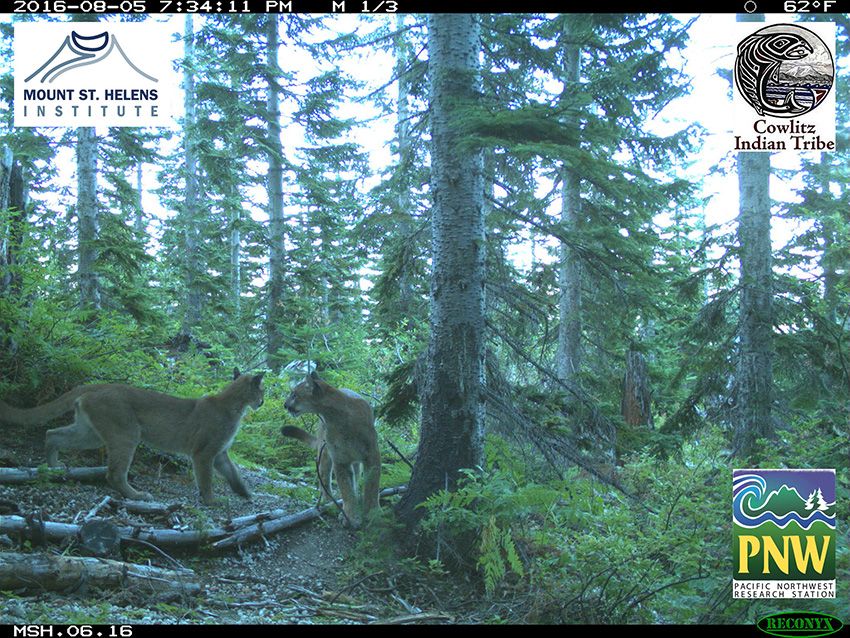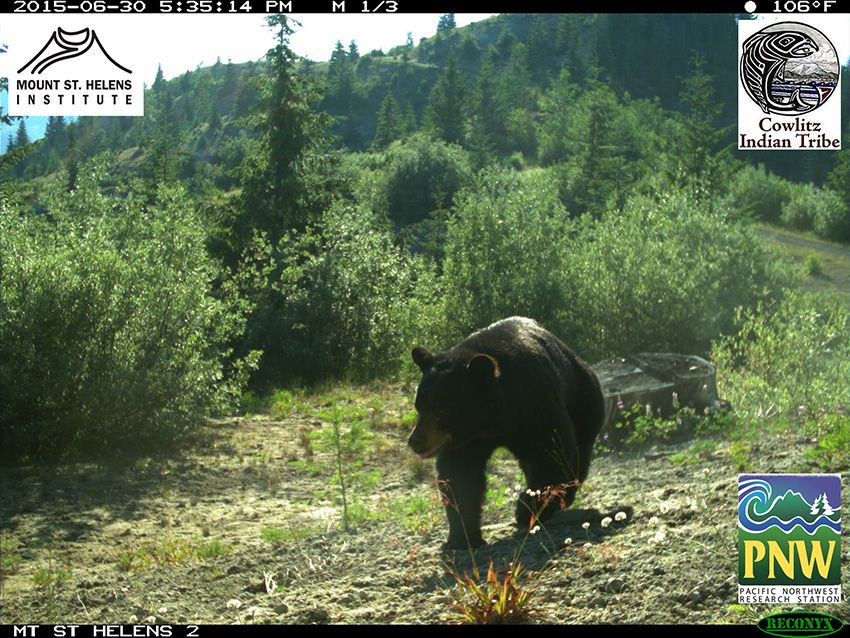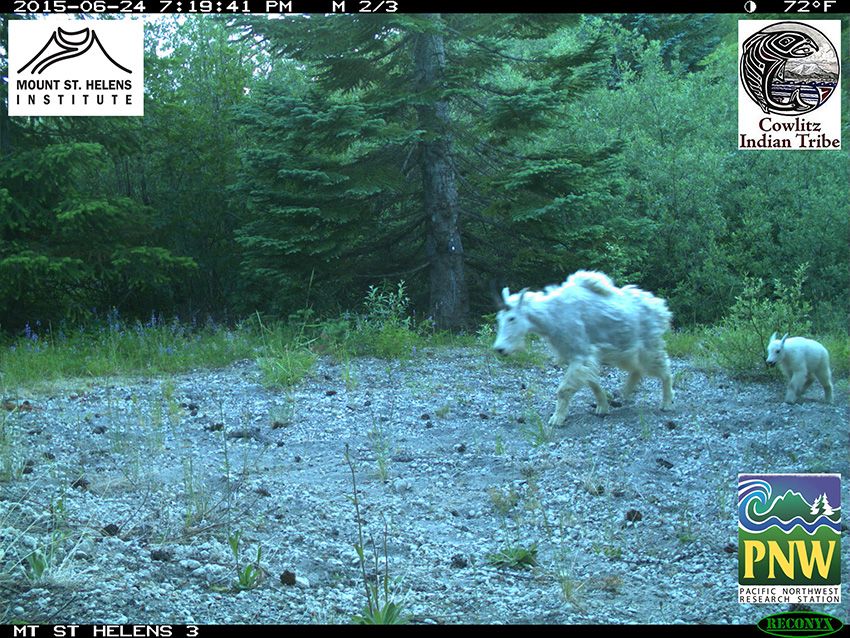
By Colleen Wieman (Communications Volunteer) and Ray Yurkewycz, Executive Director
Hidden in the forest and baited with scent, cameras are giving researchers a glimpse of wildlife in the Mount St. Helens region.
“To my knowledge, our study is the first to use a network of remote cameras to assess large mammal occurrence and abundance in the post-eruption landscape,” said Charlie Crisafulli, USFS Pacific Northwest Research Station Ecologist and collaborator in the Mount St. Helens wildlife camera project.
Although the U.S. Forest Service and the Pacific Northwest Research station have an active small mammal project near the volcano, Crisafulli stated that larger species are not easily sampled through traditional trapping methods.
“Elk are the most common mammal captured with our cameras, whereas mountain goats and puma (mountain lions) are the least common; and coyote, bobcat, American black bears and deer are intermediate in captures. These seven species were all present in our sample when we initiated the project and all have persisted over the intervening years,” Crisafulli said.
The ongoing project, a partnership that includes the Mount St. Helens Institute, Cowlitz Indian Tribe, and Pacific Northwest Research Station, began in 2014 with five camera stations. Since then, ~16 cameras have been installed during the summer months in the vicinity of Mount St. Helens, both in and out of the blast zone. The cameras are baited with a strong scent called “Gusto” every two to three weeks from June to October. The cameras capture still images that are downloaded at the end of the season.
“The cameras are located in places of animal movement; saddles, near lakes or wetlands, ridge tops, and game trails,” said Ray Yurkewycz, Executive Director MSHI, and partner in the wildlife camera project. “They are off trail and often attached to a tree or stump. We do occasionally catch people on the cameras from time to time, but they’re usually folks scouting for hunting season.”

“Wildlife populations have been monitored since the eruption by a variety of different organizations and methods,” Yurkewycz said. “The only previous camera efforts that we know of at Mount St. Helens itself were through the Cascade Carnivore project. Those cameras were specifically looking for Cascade red fox and wolverine, which were not detected.”
Other rare carnivores such as wolves have also not yet been detected.
“We expect that wolves could show up any day. Perhaps there have already been individual, dispersing wolves that have passed through,” Yurkewycz said. “Fishers were reintroduced to the Gifford Pinchot forest in the past few years, so we know they are in the area, though we have not detected them on our cameras. Wolverines have been caught on cameras nearby at Mount Adams and Goat Rocks, so it is possible that one could roam through the Mount St. Helens area.”

Mountain Goats have also been captured by the cameras. According to Nathan Reynolds, Ecologist with the Cowlitz Indian Tribe, the pre-1980 mountain goat population was unknown and the eruption was believed to have killed the entire population. The first reliable post-eruption goat-sightings within the region began in 1987 and have continued since. In 2000, mountain goat wool and tracks were observed in the crater, and in 2003 a solitary goat was frequently seen at the base of Forsyth Glacier.1In 2007, a USGS scientist in a helicopter took photos of 11 goats (four nannies and seven kids) in the Step Channel draining the western side of the crater. Since 2008, anecdotal observations of large herds on Mount St. Helens are commonplace, with groups of 15 to 20 regularly reported to USFS staffers or posted on various hiking/trail report websites.
Currently, researchers do not have population estimates based on wildlife camera observations for any of the large species, but they are hoping to pursue an analysis in the next couple of years.
“Our impression is that there are healthy numbers of all common northwest large mammals around the volcano,” Yurkewycz said. “While elk populations boomed in the wake of the eruption (lots of new forage as a result of the eruption), we know that elk populations have been declining over the past 10 years.”
Yurkewycz added that ecosystem succession is a possible reason for elk decline. “Palatable plants like grass and shrubs, that thrived post-eruption, are slowly being replaced by trees as the ecosystem continues to evolve and ‘grow up.’”
Large mammals are an integral part of the Mount St. Helens ecosystem. Researchers are curious about the impact of apex predators returning to the area.
When wolves were reintroduced to Yellowstone National Park in 1995, they changed the ecosystem, causing a top-down ripple effect through the ecosystem known as a “trophic cascade." Since wolves were extirpated in Yellowstone in the early twentieth century, mammals such as deer and elk had much less predation, and their populations boomed, having strong impacts throughout the ecosystem. Aspen groves showed little regeneration, streamside vegetation was reduced, soil composition and compaction changed.
When wolves were reintroduced, they not only reduced the ungulate population, but they also changed animal behavior. Prey learned to avoid areas they could easily be trapped in. These areas, once denuded of much vegetation, regenerated with more diverse and palatable plant communities reestablishing. Trees, released from constant browsing, were free to grow, and the new forest provided more complex habitat. With the additional streamside vegetation, rivers that used to erode through a lower water table became more stable. Beavers also moved in, and with their dams, provided additional habitat for aquatic life. Wolves also killed coyotes, which caused the rodent population to expand. With more rodents, more raptors, foxes and other animals repopulated the area.
The Mount St. Helen’s Institute is excited to observe the impact of wolves returning to the region. “Just imagine what will happen at Mount St. Helens when wolves return,” Yurkewycz said. “All aspects of the surrounding ecosystems have been heavily studied over the past 38 years since the eruption. The ability to detect the effects of wolves throughout the ecosystem will be great. Mount St. Helens is an infinitely interesting and inspiring landscape that will continue to yield scientific revelations for many decades to come."
REFERENCES